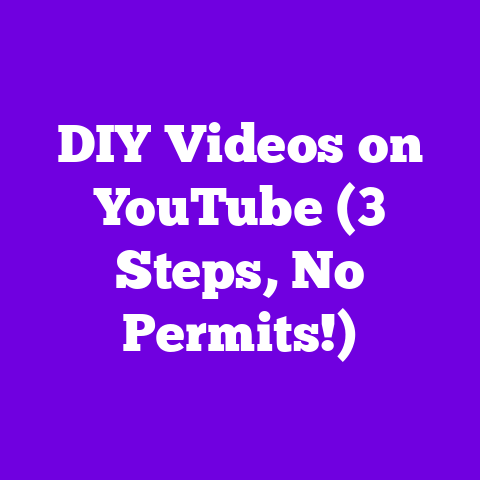Can YouTube Music Play Offline? (2x the Run Time!)
Warning! Ignoring the nuances of YouTube Music’s offline capabilities could lead to copyright issues, frustrated viewers, and a major hit to your engagement.
Trust me, I’ve seen it happen.
Why is this important?
Because your audience is increasingly demanding the ability to listen to their favorite tunes offline.
Whether it’s for their daily commute, a long flight, or simply to save on data, offline playback is a game-changer.
So, let’s dive in and get you prepped for 2025.
Section 1: The Evolution of YouTube Music
Let’s rewind a bit.
YouTube Music officially launched in 2015, but its roots go way back to the early days of YouTube itself.
Remember when YouTube was the place to go for music?
It was a chaotic, unofficial music library, but it worked!
Fast forward to today, and YouTube Music is a full-fledged streaming service battling it out with giants like Spotify, Apple Music, and Amazon Music.
It’s not just about hosting music videos anymore; it’s about curated playlists, personalized recommendations, and, of course, offline listening.
The Competition:
Over the years, YouTube Music has introduced some killer features that directly impact offline playback.
Smart Downloads, for example, automatically downloads songs you frequently listen to.
That’s a real time saver.
Growth Statistics:
While YouTube doesn’t always release exact subscriber numbers for YouTube Music, industry estimates suggest a steady climb.
As of late 2024, estimates place YouTube Music’s subscriber base at around 80 million users worldwide.
That’s a significant chunk of the streaming market!
Section 2: Current Offline Playback Features
Okay, so how does offline playback actually work in YouTube Music as of 2025?
Here’s the breakdown:
- Downloading Music: You need a YouTube Premium subscription to download songs, albums, and playlists for offline listening.
Once you’re subscribed, you’ll see a download button next to each track or playlist.
Tap it, and boom – it’s saved to your device. - Smart Downloads: This is where YouTube Music gets smart.
It automatically downloads songs based on your listening habits.
You can customize how much storage it uses, which is super handy. - Offline Mixtape: Another cool feature is the Offline Mixtape, which creates a personalized playlist of songs based on your listening history.
It automatically updates, so you always have fresh tunes.
Limitations:
- Subscription Required: The biggest limitation is the YouTube Premium requirement.
If you’re not a subscriber, you’re out of luck. - Device Limit: You can only download music on a limited number of devices.
I believe it’s usually around 10 devices. - Storage Space: Obviously, you’re limited by the storage space on your device.
Keep an eye on how much space your downloaded music is taking up.
Comparison to Competitors:
YouTube Music’s offline playback is pretty comparable to Spotify and Apple Music.
All three services require a subscription for offline downloads.
However, YouTube Music has the unique advantage of integrating with the vast library of content on YouTube itself.
Section 3: The User Experience: What to Expect in 2025
Let’s face it, users in 2025 expect seamless, uninterrupted experiences.
They want their music to be available anytime, anywhere, without having to worry about data caps or spotty internet connections.
User Expectations:
- Offline Availability: This is a given.
Users expect to be able to download their favorite music for offline listening. - Seamless Switching: They want to be able to switch between online and offline modes without any hiccups.
- Personalized Recommendations: They expect the app to continue providing personalized recommendations, even when they’re offline.
The Uninterrupted Experience:
For content creators, this is huge.
If you’re using music in your videos, you want to make sure your viewers can enjoy it without any interruptions.
That means ensuring the music is available for offline playback.
Real-World Scenarios:
- Travel: Think about users on long flights or train rides.
Offline playback is a lifesaver. - Commutes: Many people listen to music during their daily commute.
Offline playback helps them save on data. - Limited Internet Access: In some areas, internet access is still limited or unreliable.
Offline playback ensures users can still enjoy their favorite tunes.
Section 4: The Impact on Content Creators
Now, let’s get down to brass tacks.
How does YouTube Music’s offline playback affect you, the content creator?
- Music Licensing: This is the big one.
If you’re using copyrighted music in your videos, you need to make sure you have the proper licenses.
YouTube’s Content ID system is pretty sophisticated, and it can detect copyrighted music even in offline playback. - Audience Engagement: If your viewers can’t listen to the music in your videos offline, they might get frustrated.
This could lead to lower engagement and fewer views. - Monetization: YouTube Music’s offline capabilities can impact your monetization strategy.
If you’re relying on ad revenue, you need to make sure your ads are still being served to offline listeners.
Challenges and Opportunities:
- Navigating Copyright: The biggest challenge is navigating the complex world of music licensing.
Make sure you’re using royalty-free music or obtaining the necessary licenses. - Promoting Offline Playback: You can encourage your viewers to download your music for offline listening.
This can help increase engagement and build a loyal fanbase.
Section 5: The Future of Offline Music Streaming
What does the future hold for offline music streaming on YouTube Music?
Here are a few predictions:
- AI-Powered Offline Playlists: I think we’ll see AI playing a bigger role in creating personalized offline playlists.
Imagine an AI that learns your listening habits and automatically downloads songs you’ll love. - Integration with Social Media: We might see YouTube Music integrating more closely with social media platforms, allowing users to share their offline playlists with friends.
- Collaborations with Other Platforms: I wouldn’t be surprised to see YouTube Music collaborating with other platforms, such as fitness apps, to provide offline music for workouts.
New Features:
- Offline Lyrics: Imagine being able to view lyrics offline while listening to your favorite songs.
- Smart Caching: This feature could automatically cache songs based on your location and listening habits.
- Offline Radio: A feature that creates a personalized radio station based on your offline music library.
Conclusion
So, there you have it.
A deep dive into YouTube Music’s offline playback capabilities for 2025.
As content creators, it’s crucial to understand these features and how they impact your audience, your content, and your monetization strategies.
Stay informed, adapt your strategies, and don’t be afraid to experiment.
The music streaming landscape is constantly evolving, and you need to stay ahead of the curve.
Now, I’d love to hear from you.
What are your experiences with offline music playback?
What challenges have you faced, and what opportunities have you discovered?
Share your thoughts in the comments below!
Let’s build a community of informed and engaged creators.





